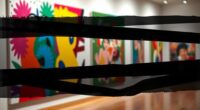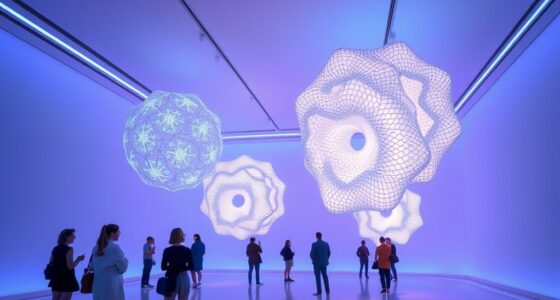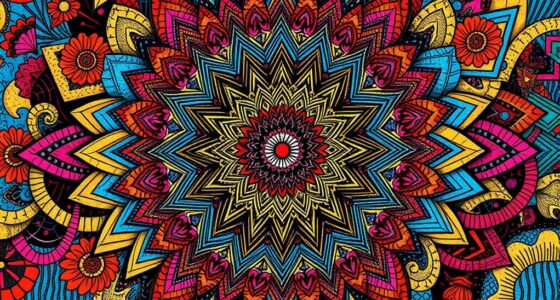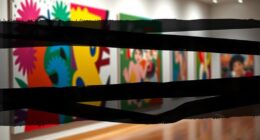Data art creatively transforms big data into immersive visual experiences that go beyond traditional charts. You can see patterns and insights through interactive displays, storytelling techniques, and sensory engagement. By blending technology, creativity, and storytelling, data art makes complex information accessible and emotionally resonant. If you keep exploring, you’ll discover how these innovative visuals challenge perceptions and foster deeper understanding of massive datasets.
Key Takeaways
- Data art transforms complex datasets into immersive visual experiences that engage and challenge perceptions.
- Interactive installations enable viewers to actively influence visualizations through sensors, touchscreens, or motion detection.
- Digital storytelling integrates narratives with data visuals, creating emotional and meaningful data-driven messages.
- Big data visualizations reveal patterns, rhythms, and concepts through visceral, real-time, and social media-inspired displays.
- Combining advanced data management with creative design, data art reimagines visualization as a fusion of technology, storytelling, and art.

Have you ever thought about how data can be transformed into visual masterpieces? When you explore the world of data art, you quickly realize it’s more than just charts and graphs. It’s about turning raw information into immersive, engaging experiences that *enchant* your senses and challenge your perceptions. One exciting way artists and designers achieve this is through interactive installations. These dynamic setups invite you to step into the artwork, often using sensors, touchscreens, or motion detectors to let you influence the visual display. As you move, click, or even speak, the data responds in real time, creating a personalized experience that blurs the line between viewer and creator. This interactivity transforms passive observation into active participation, making data visualization feel like a living, breathing entity rather than static information. It’s a powerful method for making complex data accessible and memorable, especially when combined with digital storytelling techniques. By weaving narratives into the visual design, artists can contextualize data, guiding you through a story that reveals insights or evokes emotions. For example, a digital storytelling project might use data about climate change to tell a compelling narrative about rising sea levels, with visuals that evolve as you progress through the story. The integration of storytelling elevates the data from mere numbers to meaningful messages, fostering understanding and empathy. Interactive installations and digital storytelling also open up new avenues for exploring big data’s artistic potential. Instead of drowning in spreadsheets, you get to experience the data firsthand, feeling its patterns and rhythms in a visceral way. Additionally, leveraging data management techniques such as indexing and efficient querying can enhance how these visualizations are generated and updated in real time. This approach makes the abstract tangible, helping you grasp complex concepts through sensory engagement. Whether it’s a mesmerizing light show driven by real-time social media feeds or an installation that visualizes global migration patterns, these projects demonstrate how data art can create an emotional connection. They challenge you to see data not just as information but as an expressive medium capable of conveying stories, emotions, and ideas. As you immerse yourself in these works, you become part of the narrative, influencing the visual outcome and gaining a deeper appreciation for the stories hidden within vast datasets. Data art, especially through interactive installations and digital storytelling, invites you to reimagine the possibilities of data visualization. It’s a fusion of technology, creativity, and storytelling that transforms raw data into *mesmerizing* visual experiences. In doing so, it not only showcases the beauty of data but also emphasizes its human significance, making complex information both beautiful and meaningful.
Frequently Asked Questions
How Can Data Art Influence Public Understanding of Complex Data?
Data art influences your understanding of complex data by making it more engaging and accessible. It boosts public engagement, encouraging you to explore and interpret data visually. This approach also enhances your visual literacy, helping you recognize patterns and insights that might be hidden in raw data. By transforming data into artistic visuals, you can grasp intricate information more intuitively, fostering a deeper connection and comprehension of big data concepts.
What Are the Ethical Considerations in Creating Data-Driven Art?
You must consider privacy concerns and consent issues when creating data-driven art, as symbols of trust and transparency are essential. Respect individual privacy by anonymizing data, ensuring consent is clear, and avoiding harm. If you ignore these ethical boundaries, your art risks misuse or misinterpretation, damaging trust. Ethical data art honors the stories behind the data while safeguarding the rights of those represented, fostering responsible creativity.
Which Tools Are Best for Beginners in Data Art Visualization?
If you’re new to data art visualization, start with user-friendly creative tools like Tableau, Datawrapper, or Flourish. These platforms simplify data visualization, making it easy for beginners to create compelling visuals. You can experiment with interactive dashboards or colorful charts without prior advanced skills. Focus on exploring how these tools turn big data into engaging art, and gradually learn more complex features as you gain confidence.
How Does Data Art Impact Data Privacy and Security?
You might wonder how data art impacts data privacy and security risks. It can expose sensitive information, risking breaches if not handled carefully, or it can enhance awareness of privacy issues through creative visualization. While it promotes transparency, it also requires vigilance to prevent misuse. To protect data privacy and minimize security risks, you should implement strong access controls, anonymize data, and stay mindful of ethical boundaries when creating and sharing data art.
Can Data Art Be Used Effectively in Commercial Advertising?
Yes, you can use data art effectively in commercial advertising. It enhances brand storytelling by transforming complex data into visually engaging narratives that resonate emotionally with your audience. By leveraging creative data visualizations, you engage viewers more deeply, fostering emotional engagement and making your brand memorable. This innovative approach helps you stand out in a crowded marketplace, connecting with consumers on a personal level through compelling, data-driven art.
Conclusion
You now see how data art transforms complex information into mesmerizing visuals, making big data more accessible and engaging. Did you know that by 2025, the global data sphere is expected to reach 175 zettabytes? That’s enough data to fill over 23 trillion 4K movies! With creative visualization, you can turn this overwhelming amount into meaningful stories, helping you and others understand and appreciate the power of data in ways never imagined.










